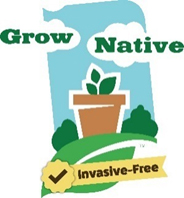With invasive plant species ruining many pristine natural areas throughout the state, Hoosier gardeners are changing the way they look at plants and are choosing to garden with plants that are native to Indiana. By doing so, they know they won’t be contributing to the spread of invasive species. But finding those native plants hasn’t always been easy. A new program called ‘Grow Native’ is changing that by promoting businesses that sell native plants, and encouraging plant sellers to sell fewer invasive plants and more native plants.
 Most invasive plant species are horticultural escapes from landscaping. Using invasive plants in landscaping, many of which are still available for sale in the nursery trade, works against healthy Indiana landscapes. By overtaking areas and eliminating a diverse mix of native plants, invasive plants harm pollinators and other wildlife, increase erosion and sedimentation in waterways, and even increase tick populations and the rate of tick-related diseases in local communities.
Most invasive plant species are horticultural escapes from landscaping. Using invasive plants in landscaping, many of which are still available for sale in the nursery trade, works against healthy Indiana landscapes. By overtaking areas and eliminating a diverse mix of native plants, invasive plants harm pollinators and other wildlife, increase erosion and sedimentation in waterways, and even increase tick populations and the rate of tick-related diseases in local communities.
Working to reduce the number of invasive plants sold by plant sellers has been a high priority for many groups in Indiana. Several of these groups are working together to sponsor the Grow Native program. This includes the Indiana Native Plant and Wildflower Society (INPAWS), The Nature Conservancy, the Indiana Academy of Science, state and federal agencies, and cooperative invasive management groups across the state.
“More and more gardeners are buying native because of all the advantages these plants provide,” said Ellen Jacquart of INPAWS. “The ‘Grow Native’ project helps put native plants in the hands of gardeners who want them.”
The Grow Native program has two levels. Any business that sells native plants is a Basic member, but those who agree to not sell invasive plants are Invasive-Free members, which earns them more promotion to customers. According to Jacquart, this free and voluntary program was an appealing way to start the conversation with plant sellers and educate them about the issue of invasive plants in horticulture. Businesses at either level can display the Grow Native decals in their windows.
Currently there are 31 certified Grow Native members, 24 of which are Invasive-Free members.
“We’ve been a member of Grow Native since it started in Monroe County,” said Jason Fulton, co-owner of Mays Greenhouse in Bloomington. “It has been a great partnership that allows us to highlight the many native perennials, trees, and shrubs we have for sale. We’ve seen increases in the sale of native plants since we joined the program, and are now carrying a more diverse selection of native plants because of it.”
Gardeners wanting to shop for native plants can find a map and directory of Invasive-Free Grow Native vendors at grownativeindiana.org.
Jacquart also encourages folks to look for that yellow “Invasive-Free” banner on the Grow Native logo whenever shopping for plants.
Why care about invasive plants?
- Invasive plants cost money. A 2012 survey of 120 agencies and landowners in Indiana found we spent $5.7million to manage these species and protect our natural areas. Nationally, agricultural and control costs due to invasive plants are estimated at $15 billion per year. Each year the cost grows.
- Invasive plants hurt wildlife by crowding out the plants our native animals need for food and cover.
- Most invasive shrubs and trees are little used by native insects. This reduces habitat for beneficial pollinators and predatory insects, as well as reducing the amount of food available for birds to feed their nestlings.
- Invasive plants destroy habitat for rare wildflowers and animals, threatening two-thirds of all endangered species.
- Invasive plants can become weedy in a home garden, crowding out other landscaping.
- Invasive plants can also decrease your ability to enjoy hunting, fishing, mushroom collecting, bird-watching, and many other recreational pursuits by crowding forest floors and choking waterways, making use of these areas difficult.
Learn more about invasive species at nature.org/invasives. The Nature Conservancy is a global conservation organization dedicated to conserving the lands and waters on which all life depends. Guided by science, we create innovative, on-the-ground solutions to our world’s toughest challenges so that nature and people can thrive together. We are tackling climate change, conserving lands, waters and oceans at unprecedented scale, and helping make cities more sustainable. Working in more than 65 countries, we use a collaborative approach that engages local communities, governments, the private sector, and other partners. Visit us online at nature.org/indiana.
